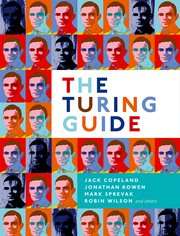The Turing Guide
The Turing Guide (2017), written by Jack Copeland, Jonathan Bowen, Mark Sprevak,[1] Robin Wilson, and others, is a book about the work and life of the British mathematician, philosopher, and early computer scientist, Alan Turing (1912–1954).
 | |
| Author | Jack Copeland, Jonathan Bowen, Mark Sprevak, Robin Wilson, et al. |
|---|---|
| Country | United Kingdom |
| Language | English |
| Subject | Alan Turing (1912–1954) |
| Genre | Non-fiction, history of science |
| Publisher | Oxford University Press |
Publication date | January, 2017 |
| Media type | Print (hardcover, paperback, e-book) |
| Pages | xv+546 |
| ISBN | 978-0-19-874783-3 |
| OCLC | 958479379 |
Overview
The book includes 42 contributed chapters by a variety of authors, including some contemporaries of Alan Turing. The book was published in January 2017 by Oxford University Press,[2] in hardcover, paperback, and e-book formats.
Contents
The Turing Guide is divided into eight main parts, covering various aspects of Alan Turing's life and work:[3]
- Biography: Biographical aspects of Alan Turing.
- The Universal Machine and Beyond: Turing's universal machine (now known as a Turing machine), developed while at King's College, Cambridge, which provides a theoretical framework for reasoning about computation, a starting point for the field of theoretical computer science.
- Codebreaker: Turing's work on codebreaking during World War II at Bletchley Park, especially the Bombe for decrypting the German Enigma machine.
- Computers after the War: Turing's post-War work on computing, at the National Physical Laboratory (NPL) and at the University of Manchester. He made contributions to both hardware design, through the ACE computer (later implemented as the Pilot ACE) at the NPL, and software, especially at Manchester using the Manchester Baby computer, later the Manchester Mark 1 and Ferranti Mark 1.
- Artificial Intelligence and the Mind: Turing's pioneering and philosophical contribution to machine intelligence (now known as Artificial Intelligence or AI), including the Turing test.
- Biological Growth: Morphogenesis, Turing's last major scientific contribution, on the generation of complex patterns through chemical processes in biology and on the mathematics behind them, foundational in mathematical biology.
- Mathematics: Some of Turing's mathematical achievements, including one of his most significant influences, Max Newman.
- Finale: Turing in a wider subsequent context, including his influence and legacy to science and in the public consciousness.
The book includes a foreword by Andrew Hodges, preface, notes on the contributors, endnotes, and an index.
Contributors
The following 33 authors contributed to chapters in the book:
- Ruth Baker
- Mavis Batey
- Margaret Boden
- Jonathan Bowen
- Martin Campbell-Kelly
- Brian Carpenter
- Catherine Caughey
- Jack Copeland
- Robert Doran
- Rod Downey
- Ivor Grattan-Guinness
- Joel Greenberg
- Simon Greenish
- Peter Hilton
- Eleanor Ireland
- David Leavitt
- Jason Long
- Philip Maini
- Dani Prinz
- Diane Proudfoot
- Brian Randell
- Bernard Richards
- Jerry Roberts
- Oron Shagrir
- Edward Simpson
- Mark Sprevak
- Doron Swade
- Sir John Dermot Turing
- Jean Valentine
- Robin Whitty
- Robin Wilson
- Stephen Wolfram
- Thomas Wooley
Reviews
The book has been reviewed by a number of journals, magazines, and professional organizations, including:[4]
- American Mathematical Society.[5]
- Engineering & Technology.[6]
- European Mathematical Society.[7]
- Formal Aspects of Computing.[8]
- Mathematical Association of America.[9]
- New Scientist.[10]
- Nuncius.[11]
- Physics World.[12]
- SIAM News.[13]
The book has also been featured online internationally, including in China.[14]
See also
- Andrew Hodges, Alan Turing: The Enigma (1983).
- Charles Petzold, The Annotated Turing (2008).
References
- "Mark Sprevak". UK: University of Edinburgh.
- "The Turing Guide". Oxford University Press. 2017.
- "The Turing Guide 2017". DBLP. Retrieved 21 May 2019.
- "The Turing Guide: Reviews and Awards". Oxford University Press. Retrieved 10 December 2017.
- "Only Human. A review by Bjørn Kjos-Hanssen" (PDF). ams.org. AMS. 2019.
- Lenton, Dominic (14 March 2017). "Book reviews: The Turing Guide, Alan Turing's life and work". Engineering & Technology.
- Bultheel, Adhemar (13 March 2018). "The Turing Guide". European Mathematical Society.
- Jones, Cliff (2017). "The Turing Guide". Formal Aspects of Computing. 29: 1121–1122. doi:10.1007/s00165-017-0446-y.
- Schulte, Tom (4 July 2017). "The Turing Guide: MAA Review". Mathematical Association of America.
- Robinson, Andrew (4 January 2017). "The Turing Guide: Last words on an enigmatic codebreaker?". New Scientist.
- Petrocelli, Carla (2018). "The Turing Guide, by Jack Copeland, Jonathan Bowen, Mark Sprevak, and Robin Wilson". Nuncius. Brill. 33 (1): 166–168. doi:10.1163/18253911-03301015.
- Cerf, Vint (January 2018). "The man behind the machine". Physics World: 38–39.
- Davis, Ernest (19 July 2017). "Paying Tribute to Alan Turing's Life and Work". SIAM News.
- Han, Bao (3 April 2018). "枷锁与馈赠|认识真实的图灵 ,一位如谜的解谜者" (in Chinese). Tencent QQ.